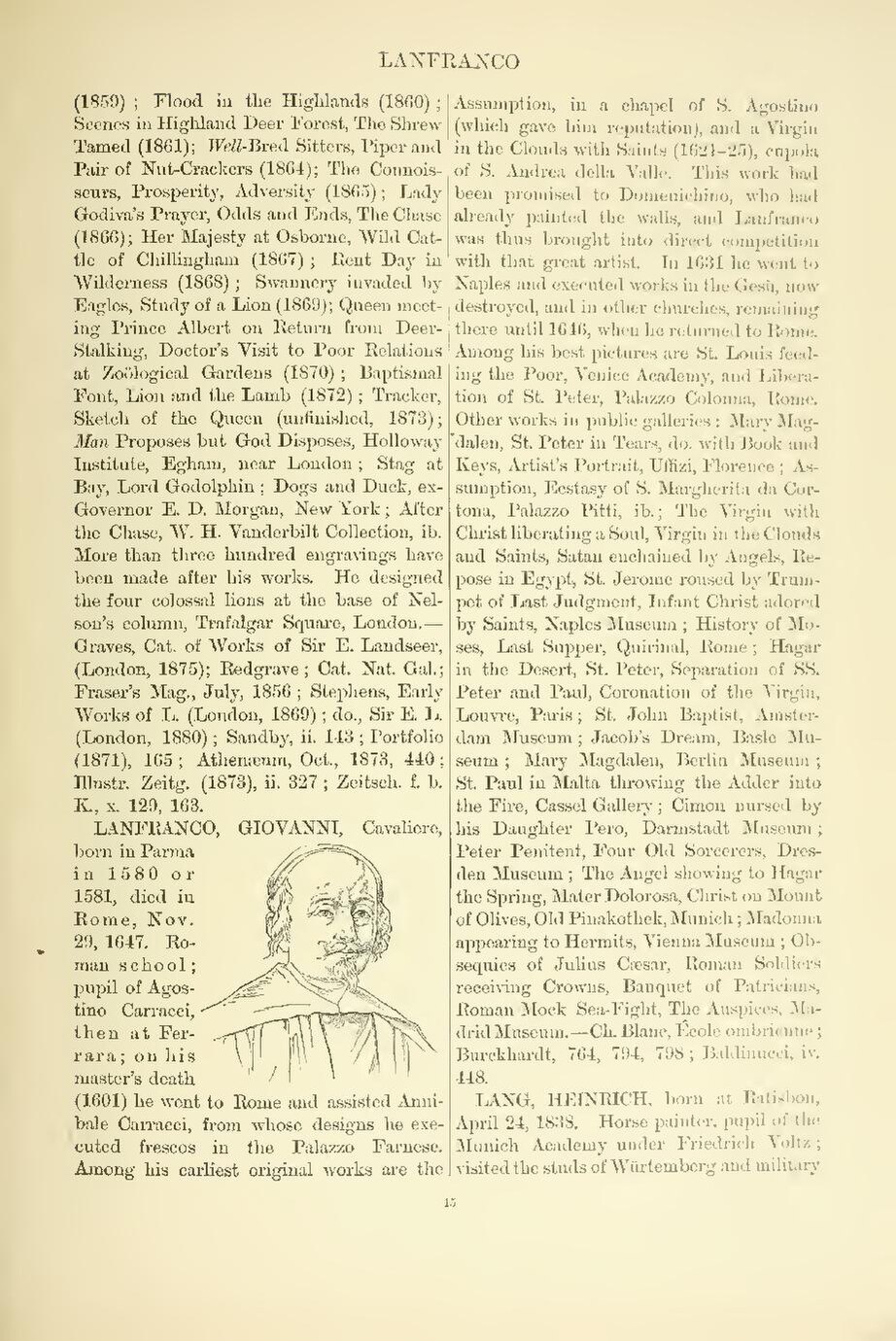(1859); Flood in the Highlands (1860); Scenes in Highland Deer Forest, The Shrew Tamed (1861); Well-Bred Sitters, Piper and Pair of Nut-Crackers (1864); The Connoisseurs, Prosperity, Adversity (1865); Lady Godiva's Prayer, Odds and Ends, The Chase (1866); Her Majesty at Osborne, Wild Cattle of Chillingham (1867); Rent Day in Wilderness (1868); Swannery invaded by Eagles, Study of a Lion (1869); Queen meeting Prince Albert on Return from Deer-Stalking, Doctor's Visit to Poor Relations at Zoölogical Gardens (1870); Baptismal Font, Lion and the Lamb (1872); Tracker, Sketch of the Queen (unfinished, 1873); Man Proposes but God Disposes, Holloway Institute, Egham, near London; Stag at Bay, Lord Godolphin; Dogs and Duck, ex-Governor E. D. Morgan, New York; After the Chase, W. H. Vanderbilt Collection, ib. More than three hundred engravings have been made after his works. He designed the four colossal lions at the base of Nelson's column, Trafalgar Square, London.—Graves, Cat. of Works of Sir E. Landseer, (London, 1875); Redgrave; Cat. Nat. Gal.; Fraser's Mag., July, 1856; Stephens, Early Works of L. (London, 1869); do., Sir E. L. (London, 1880); Sandby, ii. 143; Portfolio (1871), 165; Athenæum, Oct., 1873, 440; Illustr. Zeitg. (1873), ii. 327; Zeitsch. f. b. K., x. 129, 163.
An image should appear at this position in the text. To use the entire page scan as a placeholder, edit this page and replace "{{missing image}}" with "{{raw image|Cyclopedia of painters and paintings (IA cyclopediaofpain03cham).pdf/37}}". Otherwise, if you are able to provide the image then please do so. For guidance, see Wikisource:Image guidelines and Help:Adding images. |
LANFRANCO, GIOVANNI, Cavaliere,
born in Parma
in 1580 or
1581, died in
Rome, Nov.
29, 1647. Roman
school;
pupil of Agostino
Carracci,
then at Ferrara;
on his
master's death
(1601) he went to Rome and assisted Annibale
Carracci, from whose designs he executed
frescos in the Palazzo Farnese.
Among his earliest original works are the
Assumption, in a chapel of S. Agostino
(which gave him reputation), and a Virgin
in the Clouds with Saints (1621-25), cupola
of S. Andrea della Valle. This work had
been promised to Domenichino, who had
already painted the walls, and Lanfranco
was thus brought into direct competition
with that great artist. In 1631 he went to
Naples and executed works in the Gesù, now
destroyed, and in other churches, remaining
there until 1646, when he returned to Rome.
Among his best pictures are St. Louis feeding
the Poor, Venice Academy, and Liberation
of St. Peter, Palazzo Colonna, Rome.
Other works in public galleries: Mary Magdalen,
St. Peter in Tears, do. with Book and
Keys, Artist's Portrait, Uffizi, Florence; Assumption,
Ecstasy of S. Margherita da Cortona,
Palazzo Pitti, ib.; The Virgin with
Christ liberating a Soul, Virgin in the Clouds
and Saints, Satan enchained by Angels, Repose
in Egypt, St. Jerome roused by Trumpet
of Last Judgment, Infant Christ adored
by Saints, Naples Museum; History of Moses,
Last Supper, Quirinal, Rome; Hagar
in the Desert, St. Peter, Separation of SS.
Peter and Paul, Coronation of the Virgin,
Louvre, Paris; St. John Baptist, Amsterdam
Museum; Jacob's Dream, Basle Museum;
Mary Magdalen, Berlin Museum;
St. Paul in Malta throwing the Adder into
the Fire, Cassel Gallery; Cimon nursed by
his Daughter Pero, Darmstadt Museum;
Peter Penitent, Four Old Sorcerers, Dresden
Museum; The Angel showing to Hagar
the Spring, Mater Dolorosa, Christ on Mount
of Olives, Old Pinakothek, Munich; Madonna
appearing to Hermits, Vienna Museum; Obsequies
of Julius Cæsar, Roman Soldiers
receiving Crowns, Banquet of Patricians,
Roman Mock Sea-Fight, The Auspices, Madrid
Museum.—Ch. Blanc, École ombrienne;
Burckhardt, 764, 794, 798; Baldinucci, iv.
448.
LANG, HEINRICH, born at Ratisbon,
April 24, 1838. Horse painter, pupil of the
Munich Academy under Friedrich Voltz;
visited the studs of Würtemberg and military
